|
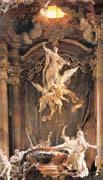 |
Egid Quirin Asam
|
|
German Baroque Era Sculptor, 1692-1750,was a German plasterer and sculptor active during the period of the Late Baroque. Born in Tegernsee, Bavaria, Asam worked mainly together with his brother, the architect and painter Cosmas Damian Asam. Because of this, their common work is often attributed to the Asam Brothers. Asam died in Mannheim. |
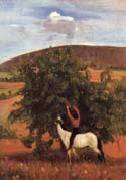 |
Egedius, Halfdan
|
|
1877-1899,Norwegian painter and illustrator. His artistic education began at the age of nine, when he enrolled at the school of art of Knud Bergslien (1827-1908) in Kristiania, where he was a pupil from 1886 to 1889. Even from this early period his painted studies and drawings, for instance of his sister Signe and brother Carl (both 1887; Oslo, N.G.), reveal striking maturity. In 1891 he was a pupil of Erik Werenskiold and from 1891 to 1892 he studied at the Arts and Crafts School in Kristiania. Egedius discovered his strongest impetus and greatest inspiration, however, on his first visit to Telemark in south-west Norway in summer 1892. The artist Torleif Stadskleiv (1865-1946), whom he met there and who became his closest friend, endeared the region to Egedius with stories of its traditions and people. In 1894 Egedius studied for a short period under Harriet Backer, and he made his d?but at the Kristiania Autumn Exhibition in 1894 with the painting Saturday Evening (Oslo, N.G.), painted in Telemark the previous year, which won high praise. In this landscape the atmosphere of the summer night is rendered with a lyrical use of colour and soft brushstrokes. Egedius spent the summer of 1894 in the inspiring and instructive company of a group of artists at V?g? in the Gudbrands Valley in north-west Norway, but for the summer of 1895 he was again in Telemark. Since his previous stay there he had matured artistically and his work now revealed a new confidence and boldness. The most notable paintings from 1895 are 'Juvrestolen' in Telemark, The Dreamer, Girls Dancing and the magnificent portrait of Mari Clasen (all Oslo, N.G.). He also began work on Music and Dance (Oslo, N.G., see fig.), which he continued the following year. |
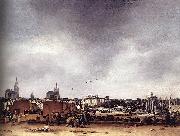 |
Egbert van der Poel
|
|
Egbert van der Poel (Delft, 1621 - Rotterdam, 1664) was a Dutch Golden Age genre and landscape painter, son of a Delft goldsmith.
He may possibly have been a student of Esaias van de Velde and of Aert van der Neer. According to the RKD he was the brother of the painter Adriaen Lievensz van der Poel and a student of Cornelis Saftleven in Rotterdam. Van der Poel was registered with the Guild of St Luke in Delft on October 17, 1650, where he is listed as a landscape painter. In 1651 van der Poel married Aeltgen Willems van Linschooten in Maassluis, near Rotterdam. His most famous paintings depict the Delft gunpowder explosion of October 12, 1654 and its aftermath; he and his wife were living in the area at the time. Egbert and Aeltgen van der Poel had a son and three daughters. He died in Rotterdam in 1664. |
 |
EERTVELT, Andries van
|
|
Flemish painter (b. 1590, Antwerpen, d. 1652, ?)
Flemish painter. He enrolled as a member of Antwerp's Guild of St Luke in 1609. In 1615 he married Catherine Vlieger (d 1627), after whose death he went to Genoa, where he worked for Cornelis de Wael. By c. 1630 he was back in Antwerp, where he had his portrait painted by Anthony van Dyck (1632; Augsburg, Schaezlerpal.). In 1633 Eertvelt married Elisabeth Boots, probably a daughter of the Antwerp painter Jan Boots (b before 1620). Eertvelt is regarded as the first Flemish marine painter. Over the years his palette and style changed. His first paintings, mostly of ships in storms (e.g. Sea Battle in a Storm; Schwerin, Staatl. Mus.), were painted in greenish-black and brown tones, often using white to highlight the rigging against the dark sea. After his tour of Italy he favoured views of southern harbours, with calm seas painted in soft tones (e.g. Spanish Ships Leaving a Port; Vienna, Ksthist. Mus.). In his day Eertvelt was a man of distinction whose artistic qualities were praised by the poet Cornelis de Bie and whose marine paintings were appreciated abroad, some being exported as far as Seville and Lisbon. |
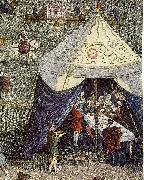 |
Eero Jarnefelt
|
|
(8 November 1863 - 15 November 1937) was a Finnish realist painter.
Eero Järnefelt was born in Viipuri, Finland. His father August Aleksander Järnefelt was an officer in the Russian army and his mother was Elisabeth Järnefelt. He studied at the St. Petersburg art academy between 1883 and 1885, the same school at which Albert Edelfelt had studied. Eero Järnefelt's sister Aino Järnefelt married composer Jean Sibelius in 1892,
Eero Järnefelt's sisters and brothers were Kasper, Arvid, Aino Ellida, Ellen, Armas, Hilja and Sigrid.
He went to study in Paris in 1886, where he became friends with Akseli Gallen-Kallela, Emil Wikström and Louis Sparre. He was inspired by the plein-air and naturalistic paintings of Jules Bastien-Lepage
On a trip to Keuruu in 1889, he met actress Saimi Swan. They were married in 1890.
His most famous painting is probably The Wage Slaves (Raatajat rahanalaiset or Kaski, from 1893, External link), depicting slash-and-burn agriculture. |
 |
EECKHOUT, Gerbrand van den
|
|
Dutch Baroque Era Painter, 1621-1674
Dutch painter, draughtsman and etcher. He was the son of the goldsmith Jan Pietersz. van den Eeckhout and 'a great friend' as well as a pupil of Rembrandt, according to Houbraken, who commented that van den Eeckhout painted in the style of his master throughout his career. This is certainly true of van den Eeckhout's (biblical) history paintings, but less so of either his portraits, which gradually displayed more Flemish elegance, or his genre pieces (from 1650), in which he followed various trends; he adapted his style to suit his subject with sensitive versatility. He was also a gifted colourist and an artist of great imagination, superior in both these respects to such better-known Rembrandt pupils as Ferdinand Bol and Nicolaes Maes. Moreover, he was extremely productive, and there is at least one dated painting for virtually every year between 1641 and 1674. In addition, he created a large body of drawings comprising histories, figures, landscapes and genre scenes executed in various media, including watercolour. |
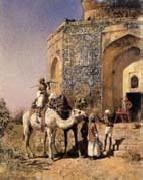 |
Edwin Lord Weeks
|
|
American Academic Painter, 1849-1903, American artist, was born at Boston, Massachusetts, in 1849. He was a pupil of Leon Bonnat and of Jean-Leon Gerome, at Paris. He made many voyages to the East, and was distinguished as a painter of oriental scenes. In 1895 he wrote and illustrated a book of travels, From the Black Sea through Persia and India, and two years later he published Episodes of Mountaineering. He died in November 1903. He was a member of the Legion d'honneur, France, an officer of the Order of St. Michael, Germany, and a member of the Secession, Munich. |
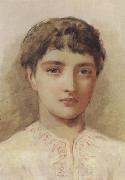 |
Edwin long,R.A.
|
|
1829-1891
.English painter. He was taught by John 'Spanish' Phillip and began his career painting portraits and Spanish subjects, such as Dialogus diversus (1873; priv. col., see Quick, p. 10). However, he became successful and rich with very large historical and biblical subjects such as the Babylonian Marriage Market (1875; Egham, U. London, Royal Holloway & Bedford New Coll.), which changed hands in his lifetime for immense sums. His choice of subject-matter was indebted to the example of Sir Lawrence Alma-Tadema, while his style closely resembles that of Edward Armitage. His success enabled him to commission two houses (1878 and 1887), both in Hampstead, from Richard Norman Shaw. He was elected ARA in 1876 and RA in 1881. |
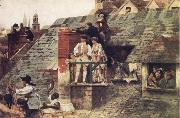 |
Edwin Howland Blashfield
|
|
mural painter and mosaic designer.
American ,1848-1936
American painter. He began to study art seriously in 1867 in Paris under L?on Bonnat, with whom he remained (except between 1870 and 1874) until 1880. Blashfield's mural style was significantly influenced by Pierre Puvis de Chavannes, Jean-Paul Laurens and Paul Baudry, whose decorations he had studied in the Panth?on while in Paris. He made a trip in 1887 to England, where he became briefly associated with the Anglo-American artists' colony in Broadway, Glos, which included Edwin Austin Abbey, John Singer Sargent, Lawrence Alma-Tadema and Frederic Leighton. |
 |
Edwin Blashfield
|
|
(December 5, 1848 - October 12, 1936), an American artist, was born in New York City.
He was a pupil of Leon Joseph Florentin Bonnat in Paris beginning in 1867, and became (1888) a member of the National Academy of Design in New York. For some years a genre painter, he later turned to decorative work, where his academic background in painting and extensive travels to study fresco painting in Italy melded in work marked by rare delicacy and beauty of coloring.
Considered a leading muralist of the late 19th century, he painted mural decorations or created mosaics in a number of places associated with the American Renaissance period.
His style is cited as an influence of Pierre Puvis de Chavannes, Jean-Paul Laurens, and Paul Baudr.
With his wife he wrote Italian Cities (1900) and edited Vasari's Lives of the Painters (1896), and was well known as a lecturer and writer on art. He became president of the Society of Mural Painters, and of the Society of American Artists.
|
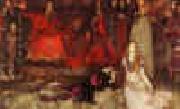 |
Edwin Austin Abbey
|
|
1852-1911
Edwin Austin Abbey Gallery
Edwin Austin Abbey (April 1, 1852 ?C August 1, 1911) was an American artist, illustrator, and painter. He flourished at the beginning of what is now referred to as the "golden age" of illustration, and is best known for his drawings and paintings of Shakespearean and Victorian subjects. His most famous work, The Quest of the Holy Grail, resides in the Boston Public Library.
Abbey was born in Philadelphia, Pennsylvania in 1852. He studied art at the Pennsylvania Academy of the Fine Arts under Christian Schuessele. Abbey began as an illustrator, producing numerous illustrations and sketches for such magazines as Harper's Weekly and Scribner's Magazine. His illustrations began appearing in Harper's Weekly at an early age: before Abbey was twenty years old. Abbey was an illustrator with Harper's Weekly from 1871-1874. He moved to England in 1878 where he was made a full member of the Royal Academy in 1898. In 1902 he was chosen to paint the coronation of King Edward VII. It was the official painting of the occasion and, hence, resides at Buckingham Palace. In 1907 he declined an offer of knighthood in order to retain his U.S. citizenship. Friendly with other expatriate American artists, he summered at Broadway, Worcestershire, England, where he painted and vacationed alongside John Singer Sargent at the home of Francis Davis Millet.
He completed murals for the Boston Public Library in the 1890s. The frieze for the Library was titled "The Quest for the Holy Grail." It took Abbey eleven years to complete this series of murals in his England studio. In 1908-1909, Abbey painted a number of murals and other artworks for the rotunda of the new Pennsylvania State Capitol in Harrisburg, Pennsylvania. His works in that building include allegorical medallions representing Science, Art, Justice, and Religion in the Capitol Rotunda, large lunette murals underneath the Capitol dome, and a number of works in the House Chamber. Unfortunately, Abbey became ill with cancer in 1911 slowing his work. At the time, he was working on the "Reading of the Declaration of Independence Mural" which was later installed in the House Chamber. Abbey was so ill, that his studio assistant, Ernest Board completed the work with little supervision from Abbey. Later in 1911, Abbey died, leaving his commission for the State Capitol of Pennsylvania unfinished. John Singer Sargent, a friend and neighbor of Abbey, and studio assistant Board completed the "Reading of the Declaration of Independence Mural." Abbey's works were installed in the Rotunda and House Chamber. Two rooms from Abbey's commission were left undone, and the remainder of the commission was given to Violet Oakley. Oakley completed the works from start to finish using her own designs.
Abbey was elected to the National Academy of Design and The American Academy of Arts and Letters. In 1937 Yale University became the home for a sizable collection of Abbey's works, the result of a bequest from Abbey's widow. |
 |
Edward William Cooke
|
|
British Painter, 1811-1880
was an English painter and gardener. Cooke was born in London. His father George and uncle, William Bernard, were both well-known engravers and Cooke was raised in their wide artistic circle. He was a precocious draughtsman and a skilled engraver from an early age, displayed an equal preference for marine subjects and published his 'Shipping and Craft' C a series of accomplished engravings C when he was 18, in 1829. He benefited from the advice of many of his father's associates, notably Clarkson Stanfield (whose principal marine follower he became) and David Roberts. Cooke began painting in oils in 1833, took formal lessons from James Stark in 1834 and first exhibited at the Royal Academy and British Institution in 1835, by which time his style was essentially formed. He went on to travel and paint with great industry at home and abroad, indulging his love of the 17th-century Dutch marine artists with a visit to Holland in 1837. He returned regularly over the next 23 years, studying the effects of the coastal landscape and light, as well as the works of the country's Old Masters, resulting in highly successful paintings. These included 'Beaching a Pink at Scheveningen' (National Maritime Museum, London), which he exhibited in 1855 at the Royal Academy, of which he was an Associate from 1851. He went on to travel in Scandinavia, Spain, North Africa and, above all, to Venice.") Cooke was "particularly attracted by the Isle of Wight, and on his formative visit of 1835 he made a thorough study of its fishing boats and lobster pots; above all he delighted in the beaches strewn with rocks of various kinds, fishing tackle, breakwaters and small timber-propped jetties He also had serious natural history and geological interests, being a Fellow of the Linnean Society, Fellow of the Geological Society and Fellow of the Zoological Society, |
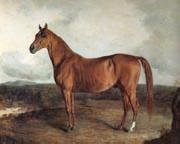 |
Edward Troye
|
|
American Artist .
b.1808 d.1874
American painter of Swiss birth. Before 1822, his father, Jean-Baptiste de Troy, a sculptor of minor fame, moved his family to England, where Edward was instructed in drawing and perhaps painting. The animal painter Jacques-Laurent Agasse knew the family well. Troye wrote in 1857 that he was trained in London by the best masters and stated that he followed the style of George Stubbs and John N. Sartorius. In 1831 Troye arrived in Philadelphia, where he was employed as a magazine illustrator. The following year he exhibited animal subjects at the annual Pennsylvania Academy of Fine Arts exhibition and rapidly found patrons among racehorse owners. His typical works show motionless, unsaddled and riderless animals against a low horizon |
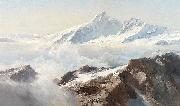 |
Edward Theodore Compton
|
|
(July 29 1849 - March 22 1921) was an English-born, German artist, illustrator and mountain climber. He is well-known for his paintings and drawings of alpine scenery, and as a mountaineer made 300 major ascents including no fewer than 27 first ascents.
Compton was born in Stoke Newington in London, the son of Theodore Compton, an art-loving insurance agent, and grew up in a deeply religious Quaker household. He attended various art schools, including, for a time, the Royal Academy in London, but otherwise he was mainly self-taught in art.
|
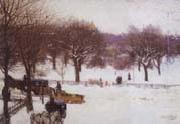 |
Edward Simmons
|
|
October 27, 1852 ?C November 17, 1931,was an American Impressionist painter, remembered for his mural work. He was born in Concord, Massachusetts, the son of a Unitarian minister. He graduated from Harvard College in 1874, and was a pupil of Lefebvre and Boulanger in Paris, where he took a gold medal. In 1894, Simmons was awarded the first commission of the Municipal Art Society, a series of murals ?? ??Justice,?? ??The Fates?? and ??The Rights of Man?? for the interior of the Criminal Courthouse at 100 Centre Street in Manhattan. This court is the criminal branch of New York Supreme Court where many New Yorkers serve on Jury Duty. Later Simmons decorated the Waldorf-Astoria hotel in New York, the Library of Congress, Washington, D.C., and the Capitol at Saint Paul, Minnesota. In the year 1914 he travelled with Childe Hassam to view the Arizona desert paintings of the rising California artist, Xavier Martinez at his Piedmont studio. Simmons was a member of the Ten American Painters, who, as a group, seceded from the Society of American Artists. He was also considered a contributor to the style known as the American Renaissance, a movement after the American Civil War that stressed the relationship of architecture, painting, sculpture and interior design. |
 |
Edward Rosenberg
|
|
painted Solnedgang i vinterlandskap in 1921
Edward Rosenberg (1858-1934)Aliases: Axel Edvard John Rosenberg; Axel Edward John Rosenberg; Edvard RosenbergProfessions: Landscape painter. |
 |
Edward Robert Hughes
|
|
British
1851-1917
Edward Robert Hughes (1851-1917) is a well known English painter who worked in a style influenced by Pre-Raphaelitism and Aestheticism. Some of his best known works are Midsummer Eve and Night With Her Train of Stars. Hughes was the nephew of Arthur Hughes. He often used watercolour/gouache. He was elected ARWS in 1891 and chose as his diploma work for election to full membership a mystical piece inspired by a verse by Christina Rossetti's "Amor Mundi". Technically Hughes experimented with ambitious techniques. He was a perfectionist who did numerous studies which in their own right turned out to be good enough for exhibition
He was also an assistant to the elderly William Holman Hunt. He helped the increasingly infirm Hunt with the version of The Light of the World now in St. Paul's Cathedral and with The Lady of Shalott. He died on April 23 1914 at his cottage in St. Albans, Hertfordshire.
|
 |
edward r taylor
|
|
Edward Richard Taylor RBSA (June 14, 1838 - January 11, 1911) was an English artist and educator. He painted in both oils and watercolours.
Taylor taught at the Lincoln School of Art and became influential in the Arts and Crafts movement as the first headmaster at the Birmingham Municipal School of Arts and Crafts from 1877-1903.
In December 1898, he founded Ruskin Pottery at Smethwick, Staffordshire. His son William Howson Taylor (1876 -1935) took over Ruskin Pottery after the death of his father. |
 |
Edward Moran
|
|
(August 19, 1829 in Bolton, Lancashire, England -June 8, 1901 in New York City) was an American artist.
He emigrated with his family to America at the age of 15, and subsequently settled in Philadelphia, where after having followed his fathers trade of weaver, he became a pupil of James Hamilton and Paul Weber. In 1862 he became a pupil of the Royal Academy in London; he established a studio in New York in 1872, and for many years after 1877 lived in Paris. He was a painter of marine subjects and examples of his work such as Devile Crag; Island of Grand Manan are in many prominent collections. Among his canvases are 13 historical paintings, intended to illustrate the marine history of America from the time of Leif Ericsson to the return of Admiral Dewey's fleet from the Philippines in 1899.
His sons Edward Percy Moran (born 1862) and Leon Moran (born 1864), and his brothers Peter Moran (born 1842) and Thomas Moran. |
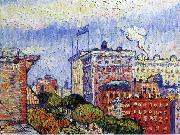 |
Edward Middleton Manigault
|
|
(June 14, 1887 - August 31, 1922) was an American Modernist painter.
Manigault was born in London, Ontario on June 14, 1887. His parents were Americans originally from South Carolina.Encouraged in art from an early age, he was commissioned at the age of 18 the city of London to make renderings of public buildings for reproduction as postcards. |
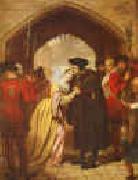 |
Edward Matthew Ward
|
|
British Painter.
1816-1879
His parents encouraged his early interest in art. He was sent to a number of art schools, including that of John Cawse (1779-1862), before gaining entry to the Royal Academy Schools in 1835. He first exhibited at the Royal Academy in 1834 with Adelphi Smith as Don Quixote (untraced). In 1836 he went abroad for further study, visiting Paris and Venice on the way to Rome, where he spent three years. His first work of any consequence was Cimabue and Giotto (untraced), which he sent back to the Royal Academy show of 1839. On the way back to England at the end of that year Ward visited Munich to learn the technique of modern fresco painting in order to take part in the competition to decorate the Palace of Westminster, but his cartoon, Boadicea (1843; untraced), was unsuccessful. However, in 1852 he was commissioned to produce eight pictures for the Palace of Westminster, on subjects drawn from the English Civil War, the best of which is the Last Sleep of Argyll (1860s) in the Commons Corridor of the Houses of Parliament
|
 |
Edward lamson Henry
|
|
A popular and prolific genre artists at the end of the 19th century
American , 181-1919
American painter. He received his first art instruction in New York from Walter M. Oddie (1808-65), followed by two years at the Pennsylvania Academy of the Fine Arts, Philadelphia (1858-60). After this he left for a two-year stay abroad, studying with Paul Weber (1823-1916), Charles Gleyre and Courbet. In 1864 he served as a captain's clerk on a boat taking supplies to the Union army. Two notable pictures that emerged from this experience were City Point, Virginia, Headquarters of General Grant (1865-72; Andover, MA, Phillips Acad., Addison Gal. A.) and Westover Mansion (1869; Washington, DC, Corcoran Gal. A.). He soon won recognition and was elected to the National Academy by 1869. Many of his paintings were sold before exhibition, |
 |
Edward La Trobe Bateman
|
|
book illuminator, draughtsman, architectural decorator and garden designer.
English
c.1815-1897
was a pre-raphaelite landscape artist, book illuminator and draughtsman. He was probably born in Derbyshire. Edward had lived in London where he had been engaged to the daughter of William and Mary Howitt. Edward visited Australia and stayed initially with Godfrey Howitt. In 1856, the Carlton Gardens in Melbourne were redesigned and Edward la Trobe Bateman was engaged to do the designs. |
 |
Edward Knowles
|
|
(born 1868 in Waberthwaite e died 29 June 1945 in Skiptone) was a rugby union footballer of the 1890s who at representative level played for England, and at club level for Millom,playing in the Forwards, e.g. Front row, Lock, or Back row. Prior to the 1899/1900 season, Millom was a rugby union club.
|
 |
Edward Jukes Greig
|
|
b. 1839 Melbourne, Victoria
Also known as E. J. G.
Artist (Draughtsman), (Cartoonist / Illustrator), (Painter)
Colonial Victorian painter, cartoonist and illustrator.
Birth datec.1839Birth placeMelbourne, VictoriaDeath date4 October 1864Death placeSydney, New South Wales.
Residence 1864 11 Crown Street, Millers Point, Sydney, New South Wales
c.1860- c.1864 171 Victoria Parade, Melbourne, Victoria
Active Period 1860- 1864
|
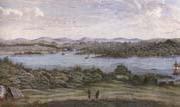 |
Edward John Eyre
|
|
1815-1901,British colonial administrator. In Australia (1833?C45) he was a magistrate, explorer, and writer on Australian geography, and had a reputation for sympathy for the aborigines. After terms as lieutenant governor of New Zealand (1846?C53) and governor of St. Vincent (1854?C60), he became (1864) governor of Jamaica. He was recalled in 1866 after suppressing a black uprising the year before in which more than four hundred Jamaicans were executed. Eyre was accused of brutality and illegal acts, especially in the execution of George Gordon, a black member of the Jamaican legislature who had contravened the martial law imposed during the emergency. He was recalled in 1866. Several attempts, promoted by John Stuart Mill, Goldwin Smith, and Herbert Spencer, to try him for murder were forestalled by a committee of admirers, which included John Ruskin, Alfred Tennyson, Thomas Carlyle, and Charles Kingsley. An English grand jury declined to indict him, and a royal commission exonerated him, while criticizing his ??unnecessary rigour.?? The episode contributed to the fall of the government of Lord John Russell in 1866. |
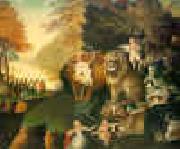 |
Edward Hicks
|
|
1780-1849
Edward Hicks (April 14, 1780 ?C August 23, 1849) was an American Folk painter, a distinguished minister of the Society of Friends, and he also became a Quaker icon because of his paintings.
Edward Hicks was born in his grandfather's mansion at Langhorne, in Bucks County, Pennsylvania. He was born into a life of luxury, and his parents were both Anglican. After his mother passed away when he was eighteen months old, Matron Elizabeth Twining - a close friend of his mother's- raised him as one of her own. She also taught him the Quaker beliefs. This had a great effect on the rest of his life.
At the age of thirteen he was an apprentice for coach makers William and Henry Tomlison. He stayed with them for seven years. His living situation inspired him to desire a much better way of life for himself. He wanted a simple, well respected life and to be able to earn his own wages. He wanted to be able to make choices for himself, in all that he did. It was then that he knew that something amusing and entertaining such as a career in art could satisfy his goals. He spent three years contemplating what his life meant to him, and grew a strong passion for art. His religious commitments affected his thoughts on living and art in many ways. In 1803, he married a Quaker woman named Sarah Worstall. |
 |
Edward Henry Potthast Prints
|
|
American Impressionist Painter, 1857-1927
Edward Henry Potthast (1857 ?C 1927) was an American Impressionist painter.
He was born in Cincinnati, Ohio. From June 10, 1879 to March 9, 1881 he studied with Thomas Satterwhite Noble. He later studied at the Royal Academy in Munich with the American-born instructor Carl Marr. After returning to Cincinnati in 1885 he resumed his studies with Noble. In 1886 he departed for Paris, where he studied with Fernand Cormon. In 1895 he relocated to New York City and remained there until his death in 1927. |
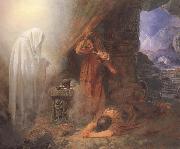 |
Edward Henry Corbould,RI,RWS
|
|
1815-1905
Painter, illustrator and sculptor, son of (2) Henry Corbould. A pupil of Henry Sass (1788-1844) and a student at the Royal Academy, he showed more wide-ranging interests than his father or uncle. He worked in watercolour and briefly in sculpture, winning gold medals for both from the Society of Arts (Fall of Phaeton, watercolour, 1834; St George and the Dragon, sculpture, exh. RA 1835; both untraced). He designed monumental figures for an unexecuted London County Council sculpture project for Blackfriars Bridge (1889), but he concentrated primarily on watercolours of literary and historical subjects, which he exhibited with the New Water-Colour Society from 1837 until 1898. |
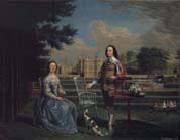 |
Edward Haytley
|
|
British Painter, active 1740-ca.1762,was an English portrait and landscape painter of the 18th century. Little is known about him, but the background of some of his sitters and professional contacts suggest he may have come from Lancashire. Few of his works survive, but he appears to have specialised in the "conversation piece" form popular with the landed gentry of mid-18th century England, a group portrait against an idealised backdrop of the subjects' estates. His works of this form include one of Elizabeth Robinson with her parents, Edward and Elizabeth Montagu, at Sandleford Priory near Hythe, Kent; six portraits of the Stanley family including one of Sir Robert and Lady Bradshaigh in front of Haigh Hall; and two of the Brockman family on its Kent estate, Beachborough, both showing the newly-constructed Temple Pond. One of the latter may include Susanna Highmore, daughter of the portrait painter Joseph Highmore. His best known works are the oil-on-canvas roundels of Bethlem and Chelsea Hospitals donated in 1740, at the behest of William Hogarth, to the Foundling Hospital, London. His last recorded work was a conversation piece of William Milner, second baronet, dated 1764, and he is assumed to have died shortly after this date |
 |
Edward Burne-Jones
|
|
British Pre-Raphaelite Painter, 1833-1898
English painter and decorative artist. He was the leading figure in the second phase of the Pre-Raphaelite movement. His paintings of subjects from medieval legend and Classical mythology and his designs for stained glass, tapestry and many other media played an important part in the Aesthetic Movement and the history of international Symbolism. |
 |
Edward Burne Jones
|
|
Sir Edward Coley Burne-Jones, 1st Baronet (28 August 1833 - 17 June 1898) was a British artist and designer closely associated with the later phase of the Pre-Raphaelite movement, who worked closely with William Morris on a wide range of decorative arts as a founding partner in Morris, Marshall, Faulkner, and Company. Burne-Jones was closely involved in the rejuvenation of the tradition of stained glass art in England; his stained glass works include the windows of St. Philip's Cathedral, Birmingham, Holy Trinity Church, Sloane Square, Chelsea, St Martin's Church in Brampton, St Michael's Church in Brighton, Cumbria, the church designed by Philip Webb, All Saints, Jesus Lane, Cambridge and in Christ Church, Oxford.
Burne-Jones's early paintings show the heavy inspiration of Dante Gabriel Rossetti, but by the 1860s Burne-Jones was discovering his own artistic "voice". In 1877, he was persuaded to show eight oil paintings at the Grosvenor Gallery (a new rival to the Royal Academy). These included The Beguiling of Merlin. The timing was right, and he was taken up as a herald and star of the new Aesthetic Movement.
In addition to painting and stained glass, Burne-Jones worked in a variety of crafts; including designing ceramic tiles, jewellery, tapestries, mosaics and book illustration, most famously designing woodcuts for the Kelmscott Press's Chaucer in 1896.
Edward Coley Burne Jones (the hyphen came later) was born in Birmingham, the son of a Welshman, Edward Richard Jones, a frame-maker at Bennetts Hill, where a blue plaque commemorates the painter's childhood. His mother Elizabeth Coley Jones died within six days of his birth, and he was raised by his grieving father and the family housekeeper, Ann Sampson, an obsessively affectionate but humorless and unintellectual local girl. He attended Birmingham's King Edward VI grammar school from 1844 and the Birmingham School of Art from 1848 to 1852, before studying theology at Exeter College, Oxford. At Oxford he became a friend of William Morris as a consequence of a mutual interest in poetry. The two Exeter undergraduates, together with a small group of Jones' friends from Birmingham known as the Birmingham Set, speedily formed a very close and intimate society, which they called "The Brotherhood". The members of the Brotherhood read John Ruskin and Tennyson, visited churches, and worshipped the Middle Ages. At this time Burne-Jones discovered Thomas Malory's Le Morte d'Arthur which was to be so influential in his life. At that time neither Burne-Jones nor Morris knew Rossetti personally, but both were much influenced by his works, and met him by recruiting him as a contributor to their Oxford and Cambridge Magazine which Morris founded in 1856 to promote their ideas.[ |
 |
Edward Beyer
|
|
painted The Peaks of Otter and the Town of Liberty in 1855 |
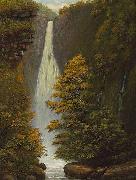 |
Edward Bailey
|
|
(1814-1903) was the most accomplished of the missionary artists in Hawaii. Along with his wife, Bailey arrived in Hawaii as a missionary-teacher in 1837 on the ship Mary Frazier. He worked at the Wailuku Female Seminary in Maui from 1840 until its closure in 1849. After the seminary closed, he built the still standing Ka'ahumanu Church in Wailuku and operated a small sugar plantation that eventually became part of the Wailulu Sugar Company. He began painting about 1865, at the age of 51, without any formal instruction.
Bailey's best known paintings are landscapes depicting the natural beauty of central Maui, The Bailey House Museum (Wailuku, Hawaii) and the Lyman House Memorial Museum (Hilo, Hawaii) are among the public collections holding works by Edward Bailey.
|
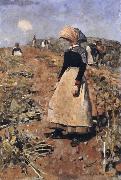 |
Edward Arthur Walton
|
|
British Painter, 1860-1922
He trained at the Staatliche Kunstakademie in Desseldorf (1876-7) and Glasgow School of Art. One of the GLASGOW BOYS, he painted outdoors in the Trossachs and at Crowland, Lincs, with James Guthrie, Joseph Crawhall and George Henry. He also painted in W. Y. Macgregor's life studio in Glasgow. He joined the New English Art Club in 1887 and developed an atmospheric landscape style influenced by plein-air painting and by James McNeill Whistler with whom he was friendly during his stay in London (1894-1904); Autumn Sunshine (1884; U. Glasgow, Hunterian A.G.) is characteristic. Walton was a regular exhibitor from 1880 in both Glasgow, at the Institute of the Fine Arts, and Edinburgh, at the Royal Scottish Academy. He was elected an Associate of the Academy in 1889 and a full member in 1905, taking an active role in its affairs after moving to Edinburgh in 1904. He concentrated after c. 1885 on pastel and on watercolour, which he used notably in his Helensburgh and Kensington scenes of contemporary life. From 1915 he served as President of the Royal Scottish Water Colour Society. Oil was reserved largely for portraits in a Whistlerian style, such as the Artist's Mother. |
 |
Edward Armitage
|
|
(May 20, 1817 - May 24, 1896) was an English Victorian era painter whose work focussed on historical, classical and biblical subjects.
Armitage was born in London to a family of wealthy Yorkshire industrialists, the eldest of seven sons of James Armitage (1793 - 1872) and Anne Elizabeth Armitage nee Rhodes (1788 - 1833), of Farnley Hall, just south of Leeds, Yorkshire. His great-grandfather James (1730 - 1803) bought Farnley Hall from Sir Thomas Danby in 1799 and in 1844 four Armitage brothers, including his father James, founded the Farnley Ironworks, utilising the coal, iron and fireclay on their estate. His brother Thomas Rhodes Armitage (1824 - 1890) founded the Royal National Institute of the Blind.
Armitage was the uncle of Robert Armitage (MP), the great-uncle of Robert Selby Armitage, and first cousin twice removed of Edward Leathley Armitage.
|
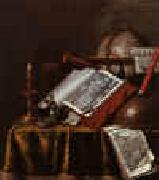 |
Edwaert Collier
|
|
Dutch
1640-1706
Evert Collier was born about 1640 in Breda, Noord-Brabant, and died in 1708. He is believed to have trained in Haarlem, as his earliest paintings show the influence of Pieter Claesz and Vincent Laurensz van der Vinne. By 1667, he had moved to Leiden, where he became a member of the Guild of St. Luke in 1673. He moved to Amsterdam by 1686 and to London in 1693. He was buried September 8, 1708 at St. James, Piccadilly.
The Denver Art Museum, the Honolulu Academy of Arts, the National Portrait Gallery (United Kingdom), the Rijksmuseum (Amsterdam) and the Tate (London) are among the public collections having paintings by Evert Collier. |
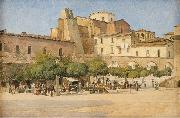 |
Edvard Petersen
|
|
(4 February 1841 - 5 December 1911) was a Danish painter. He also designed the Stork Fountain on Amagertorv in Copenhagen
From 1851 he attended the Royal Danish Academy of Fine Arts. In the 1860s and 1870s he painted romantic landscape paintings under influence of Vilhelm Kyhn. He was a close friend of fellow painter Theodor Philipsen and together they went on several travels, including two stays in Italy between 1875 and 1880 and a visit to France.The friendship did not seem to influence Petersen's rather conservative style of painting and his works from the times abroad are generally traditional paintings of local life.
In the 1880s Petersen painted a number of figure paintings of street life in Copenhagen under influence of French Realism. His most famous paintings are Emigrants on Larsens Plads (1880) and A Return, the America Liner at Larsens Plads (894).
With his Stork Fountain proposal, Petersen won the competition for the design of a new fountain on Amagertorv in Copenhagen in 1888. The sculptor Vilhelm Bissen moulded the birds and the fountain was inaugurated in 1904
|
|

